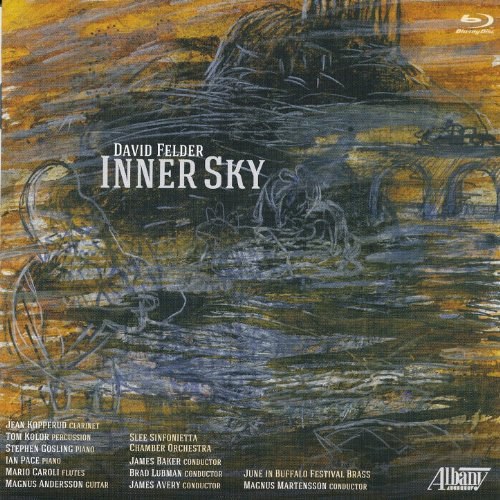- Inner Sky
: Review
When I wrote about Felder's flute concerto Inner Sky (1994, rev. 1999) in a concert review of Tanglewood's 2011 Festival of Contemporary Music, I mentioned how much I looked forward to hearing the piece again on its (then in preparation) recording. What I didn't mention at the time: my concern that it would be difficult to capture the many details of the piece on record. Enter blu-ray audio.
Indeed, David Felder's music is perfect to demonstrate the capacities of blu-ray audio. Musical climaxes feature piercingly fierce highs and rumbling lows. Elsewhere, shimmering diaphanous textures, frequently blending electronic and acoustic instruments, surround one immersively in this multi-channel environment. By the way, if one doesn't have access to blu-ray, the recording package also includes an audio CD.
One of the magical things about Inner Sky, not just as a demonstration of an audio platform but as an expertly crafted composition, is the use of register to delineate the structuring of the three main facets of the piece: its solo part, the orchestra, and the electronics. Over the course of Inner Sky, flutist Mario Caroli is called upon to play four different flutes: piccolo, concert flute, alto flute, and bass flute. Moving from high to low, he negotiates these changes of instrument, and the challenging parts written for each of them, with mercurial speed and incisive brilliance. Even though all of the orchestra members are seated onstage, we are also treated to a spatialization of sorts through the frequent appearance of antiphonal passages. This ricochet effect is more than matched by the lithe quadraphonic electronic component. Featuring both morphed flute sounds and synthetic timbres that often respond to the orchestration, it is an equal partner in the proceedings.
Tweener (2010) a piece for solo percussion, electronics, and ensemble, features Thomas Kolor as soloist. Kolor is called upon to do multiple instrument duty too, using "analog" percussion beaters as well as a KAT mallet controller. An astounding range of sounds are evoked: crystalline bells, bowed metallophones, electronically extended passages for vibraphone and marimba. The percussionist's exertions are responded to in kind by vigorous orchestra playing from University of Buffalo's Slee Sinfonietta Chamber Orchestra, conducted by James Baker. The Slee group flourishes here in powerful brass passages, avian wind writing, and soaring strings. The brass pieces Canzonne and Incendio are also played by UB musicians in equally impressive renditions. These works combine antiphonal writing with a persuasive post-tonal pitch language that also encompasses a plethora of glissandos.
The Slee Sinfonietta again, this time conducted by James Avery, gets to go their own way on Dionysiacs. Featuring a flute sextet, the piece contains ominously sultry low register playing, offset by some tremendous soprano register pileups that more than once remind one of the more rambunctious moments in Ives's The Unanswered Question. What's more, the flutists get to employ auxiliary instruments such as nose whistles and ocarinas, adding to the chaotic ebullience of the work (entirely appropriate given its subject matter).
Clarinetist Jean Kopperud and pianist Stephen Gosling are featured on Rare Airs, a set of miniatures interspersed between the larger pieces. These works highlight both musicians' specialization in extended techniques and Kopperud's abundant theatricality as a performer. Pianist Ian Pace contributes the solo Rocket Summer. Filled with scores of colorful clusters set against rangy angular lines and punctuated by repeated notes and widely spaced sonorous harmonies, it is a taut and energetic piece worthy of inclusion on many pianists' programs.
Requiescat (2010), performed by guitarist Magnus Andersson and the Slee Sinfonietta, again conducted by Baker, is another standout work. Harmonic series and held altissimo notes ring out from various parts of the ensemble, juxtaposed against delicate guitar arpeggiations and beautifully complex corruscating harmonies from other corners. Once again, Felder uses register and space wisely, keeping the orchestra out of the guitar's way while still giving them a great deal of interesting music to play. Written relatively recently, Requiescat's sense of pacing, filled with suspense and dramatic tension but less inexorable than the aforementioned concerti, demonstrates a different side of Felder's creativity, and suggests more efficacious surprises in store from him in the future.
